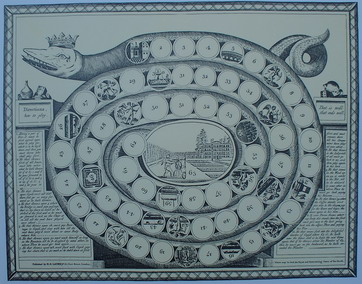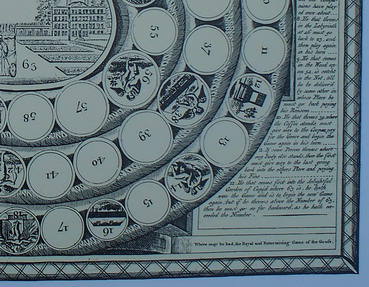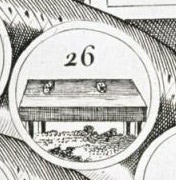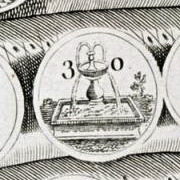Giochi dell'Oca e di percorso
(by Luigi Ciompi & Adrian Seville)
(by Luigi Ciompi & Adrian Seville)

|
Giochi dell'Oca e di percorso
(by Luigi Ciompi & Adrian Seville) |

|
 |

Torna alla ricerca giochi (back to game search) |
 |
| Royal (The) Pastime of Cupid or Entertaining Game of the Snake | ||
 |
Versione stampabile
 |
Invia una segnalazione

|
                 |
primo autore: | Non indicato |
| secondo autore: | Robert Laurie - James Whittle - Richard Holmes Laurie | |
| anno: | 1850 | |
| luogo: |
Inghilterra-Londra |
|
| periodo: | XIX secolo (3°/4) | |
| percorso: | Percorso di 63 caselle numerate | |
| materiale: | carta (paper) (papier) | |
| dimensioni: | 387X505 | |
| stampa: | Acquaforte (taille-douce) (ecthing) | |
| luogo acquisto: | ||
| data acquisto: | ||
| dimensioni confezione: | ||
| numero caselle: | 63 | |
| categoria: | Amore, matrimonio e famiglia | |
| tipo di gioco: | Gioco di percorso | |
| editore: | Laurie Richard Holmes | |
| stampatore: | Published by R. H. Laurie N°53 Fleet Street, London | |
| proprietario: | Privato | |
| autore delle foto: | L. Ciompi | |
| numero di catalogo: | 862 | |
| descrizione: |
Gioco di 63 caselle numerate, spirale, orario, centripeto che ha la forma di un serpente. Questo gioco forse si ispira ad un gioco della metà del XVIII secolo realizzato da Robert Sayer, mercante di carte e di stampe a cui successero nel 1794 Robert Laurie e James Whittle e nel 1813 Richard Holmes Laurie. L'antico gioco egiziano del serpente, di forma spirale, può aver ispirato molti giochi di società, ma le regole rimangono sconosciute. Nel Gioco del Serpente alla casella 63 (“The Delightfull Garden of Cupid") si può osservare: - tre coppie di amanti con Cupidi fra le nuvole (De Jode Pieter 1620ca / Veuve Petit 1640ca); - Cupido che affila la punta della sua freccia in un giardino (Laurie&Whittle, 1794 / Lumsden, 1810-1830ca / R. H. Laurie,1850ca); - una coppia contadina che balla accompagnata da un Cupido che suona uno strumento (Visscher, 1625ca / Garrett, 1690ca / Dicey, 1736-40); - un Cupido da solo con il suo arco (Carington Bowles 1756 / Bowles&Carver 1763-1780ca); - due personaggi che giocano a tavola in presenza di un Cupido (Anonimo XVIII° secolo). In questo esemplare al centro troviamo un Cupido che affila la punta della sua freccia e una casella con i dadi è al 26 anziché al 25. In basso a sinistra: "Published by R. H. Laurie N°53 Fleet Street, London" e a destra; "Where may be had the Royal and Entertaining Game of the Goose". Non esiste una versione italiana di questo gioco ad esclusione de "Il Novo et Piacevol Gioco del Giardin d’Amore (Arch. n°1105) che a parità di tema si gioca però come il gioco della civetta. REGOLE: ai lati del tavoliere. CASELLE: mute. Cas. 1) Porta; Cas. 5) Ponte; Cas. 7) Cupido; Cas. 12) Sedia; Cas. 14) Cupido; Cas. 16) Tavolo con dadi (6+1); Cas. 18) Cupido; Cas. 21) Cupido; Cas. 26) Tavolo con dadi (5+2); Cas. 28) Cupido; Cas. 30) Fontana; Cas. 35) Cupido; Cas. 38) Cupido; Cas. 42) Cupido; Cas. 43) Tavolo con dadi (3+4); Cas. 46) Labirinto; Cas. 49) Cupido; Cas. 54) Bosco; Cas. 56) Cupido; Cas. 59) Sepolcro; Cas. 63) Cupido che affila la punta di una freccia. NOTA: vedi esemplari Arch. n°1240, Arch. n°1309, Arch. n°2341, Arch. n°2342, Arch. n°2354, Arch. n°2487, Arch. n°2488, Arch. n°2489, Arch. n°2490. REFERENZA 1 The game begins at the head of the coiled snake and finishes at centre, where Cupid is depicted in the gardens of love. Players move through sixty three places with each throw of the dice. The places are illustrated with cupids and obstacles symbolic of the rewards and risks of love. Instructions are printed at either side of the snake. The Royal Pastime of Cupid (a version of the older Game of Goose) was published in around 1750 by the London print seller Robert Sayer (1725-94). Richard Holmes Laurie, the publisher of this impression, is believed to have inherited the original plate from his father Richard Laurie who succeeded Sayer’s firm. (British Library) REFERENZA 2 "The Royal Pastime of Cupid or Entertaining Game of the Snake". (V&A Museum) The Game of the Snake is an adaptation of the Game of the Goose. It is known to have been first published in about 1750. It is likely that this particular version is an impression from the original engraving plate with some of the lettering altered. The game begins near the head of the snake and finishes at its tail. Instead of having a separate rule booklet, the instructions for playing the game are printed on either side of the snake. Physical description Design: engraving, uncoloured; designed as a coiled snake; numbered in a clockwise direction from the top right hand corner by the head of the snake. N°of squares: 63 Squares illustrated: cupids and hazards Square numbering: 1 to 63 Squares titled: some Subject of starting square: castle Subject of ending square: oval, Garden of Cupid Place of Origin: London Date: ca. 1850 Artist/maker: R. H. Laurie Materials and Techniques: Engraving on paper with linen backing Dimensions: Height: 15.25 in; width: 19.9 in Object history note: An edition of the Game of the Snake (an adaptation of the Game of the Goose) is known to have been issued by Robert Sayer about 1750. Robert Laurie and James Whittle succeeded Sayer at his premises at 53 Fleet Street in 1794 and were in turn succeeded by R. H. Laurie in 1813; it would appear that the above is an impression from the original plate with altered lettering. R. H. Laurie, 53 Fleet Street, 1813-59 Historical context note Rewards: receipt of counters, forward movement and extra turns Forfeits: payment of counters, backward movement, missing turns N°of Players: any Equipment required: dice, markers, counters Rules: Directions, how to play: 1. Having a pair of dice, it must be first agreed upon what to play for, which is to be lay'd down and then you must throw who shall play first. 2. He that throws first of all seven must take notice of what he hath thrown for if it be 1 and 6 he goes forward to 16, if it be 2 and 5 to 25, if it be 4 and 3 he goes to 43. 3. He that throws upon Cupid, must not rest there but go as many forward as he hath thrown. 4. He that throws upon 5 where the Bridge is, must pay passage, that is, lay down as much as he staked at first, and so he must go forward to rest on the chair at 12, till all the rest have played once more. 5. He that throws upon 18, must pay Beverage to Cupid and stay with him till the rest have play'd twice about or some body release him. 6. He that throws upon 30, must wash himself so long in the Fountain, till he be displac'd by some other, in whose place he must go back again. 7. He that throws upon 38, must feast with Cupid paying his share, that is as much as he stak'd down at first, and must remain there till his companions have played once about. 8. He that throws in the Labyrinth at 46 must go back to 23 and then play again in his turn. 9. He that comes in the Wood upon 54, is catcht in the net, till he be delivered by some other in whose place he must go back paying his ransom. 10. He that throws upon 59, where the coffin stands must give way to the corpse, pay for the grave and begin the game again in his turn. 11. If some person throws were any body else stands, then the first must give way to the last going back into the other's place and paying his fine. 12. He that comes first into the delightful Garden of Cupid where 63 is, he hath won the Game and is to begin the new game again, but if he throws above the Number 63, then he must go so far backward, as he hath exceeded the number. The ancient Egyptian game of the snake, also a spiral pattern, may have inspired many race games, but the rules of this game are not knwon and they are unlikely to have been the same, although the aim of the game was to the same-to win. The reissuing of existing and popular games was, often by different publishers, common practice. Often the only changes made were to the names and dates, but occasionally extra compartments were added, such as the updating of an historical game from King George III's period to include Queen Victoria. Rules placement: engraved each side of the snake Descriptive line: Engraved game, The Royal Pastime of Cupid, published in England by R. H. Laurie about 1850. REFERENZA 3 WHITEHOUSE, Francis Reginald Beaman, (pag. 56): THE ROYALL PASS-TYME OF CUPID, or the New & Most Pleasant Game of The Snake. Printed and sould by John Garrett at his Shop next ye Stayres of ye Royall Exchange in Cornhill. An engraving on laid paper uncut and uncoloured, size 18 in X 14 ¾ in, representing a coiled snake wearing a crown on his head, upon the coils are 62 circles, No. 63, the central panel, is termed “The Delightfull Garden of Cupid". The complete "Directions how to play” are as follows: 1 “Haveing a pare of dice, it must be first agreed upon, what to play for, which is to be layd downe, & then you must throw - who shall play first. 2 “He that throws first of all Seven, must take notice what he hath throwne, for if it be 1 & 6, he goes forward to 16, if it be 2 & 5, to 25, if it be 4 and 3, he goeth to 43. 3 “He that throws upon cupid must not rest there, but goe as many forward as he hath throwne. 4 "'He that throws upon 5 where the bridge is, must pay passage: that is, lay downe as much as he stake at ye first, and so he must goe forward to rest on ye chayre at 12 till all the rest have played once about. 5 “He that throws upon 18, must pay beveridge to Cupid, & stay with him till ye rest have played twice about or some body releace him. 6 “He that throws upon 30 must wash him self so long in ye fountayne till he be displaced by some other in whose place he must goe back agin. 7, "He that throws upon 38 must feast with Cupid, paying his share that is as much as he stakt downe at first, & must remayne there till his Companions have played once about. 8 “He that throws in ye labyrinth which is 46, must goe back to 23, & then play agin in his turne. 9 “He that comes in ye wood upon 54, is catcht in ye net, till he be delivered by sum other, in whose place he must goe back, paying his ransome. 10 "He that throws 59, where ye coffin stands, must give way to ye corps, pay for ye grave, & begin ye game again in his turne. 11 “If some person throws where any body else stands, then the first must give way to ye last going back into ye others place, paying his fine. 12 “He that comes first into the delightfull garden of Cupid, where 63 is he hath wun ye game: & is to begin ye new game againe, but if in case he throws above ye number of 63, then he must goe so far back ward, as he hath exceeded ye number.” This game is so similar both in appearance and operation to The Royall & Most Pleasant Game of the Goose-both tracks are of 63 numbers: No 58 "Where Death ls” (Goose), 59 “Where Ye Coffin Stands” (Snake)-that in all probability the popularity of the former inspired the publication of the latter. These two games are very rare; the reason is obvious-being uncut and not mounted on linen, they became creased or torn and ultimately would be thrown away. These two games were engraved half a century before Trafalgar and Waterloo were fought, whilst the Second George sat on the English Throne, and America was an English Colony. REFERENZA 4 "Les variations sur le thème de l'oie sont nombreuses, meme sans compter les jeux éducatifs. The Royal Pastime of Cupid (Le jeu de Cupidon) ou le Entertaining Game of the Snake (Jeu amusant du serpent) ont des règles similaires et furent édités par Richard Holmes Laurie vers 1850. Cette gravure non colorée est peut-etre inspirée d'un plateau de jeu de la moitié du XVIIIe siècle, produit pour Robert Sayer, marchand de cartes et d'imprimés ayant pignon sur rue, à qui Robert Laurie et James Whittle succédèrent en 1794, puis Richard H. Laurie en 1813. L'antique jeu égyptien du serpent un modèle aussi en forme de spirale, peut avoir inspiré de nombreux jeux de societé, mais les règles nous en sont toujours inconnues et elles ne furent surement pas similaires, meme si le but du jeu était toujours de gagner. La réédition de jeux déja existants et populaires par différents éditeurs était une pratique corante. Très souvent, les changements ne concernaient que les noms et les dates, mais il arrivait que des cases soient rajoutées par exemple dans le cas d'un jeu historique de l'époque du roi George III que l'on remit au gout du jour pour y inclure la reine Victoria." (GOODFELLOW Caroline) REFERENZA 5 "Variations on the theme of the goose are numerous, even without including educational games. The Royal Pastime of Cupid, or Entertaining Game of the Snake, has similar rules and was published by Richard H. Laurie in about 1850. This uncoloured engraving may have been taken from a mid-18th century plate produced for Robert Sayer, a well-established map and print seller, who as succeded by Robert Laurie and James Whittle in 1794 and by Richard H. Laurie in 1813. The ancient Egyptian Game of the Snake, also a spiral pattern, may have inspired many race games, but the rules of this game are not known and they are unlikely to have been the same, although the aim of the game was the same-to win. The reissuing of existing and popular games was, often by different publishers common practice. Often the only changes made were to the names and dates, but occasionally extra compartments were added, such as the updating of an historical game from King George III's period to include Queen Victoria." (GOODFELLOW Caroline) REFERENZA 6 The Royal Pastime of Cupid or Entertaining Game of the Snake The Game of the Snake is an adaptation of the Game of the Goose Game of Goose. It is a simple roll and move game played with two dice, with spaces that cause you to move back, lose a turn, etc. If one reads the rules which are printed on the game board, there is also an element of gambling as well as elements of an early party or drinking game. The game starts by the players agreeing on "what to play for," "which is to be lay'd down and then you must throw who shall play first." Some spaces require the player to put up an additional wager: "He that throws upon 38 must feast with Cupid paying his share, that is, as much as he stak'd down first, and must remain there till his Companions have play'd once about." If you land on space 30 you have to wash yourself in the fountain "until dispac'd by some other." If you land on 59, the bottle space, the player is "to drink a Glass and pay a stake till his turn comes to throw again." The earliest known version was published in Antwerp, ca. 1620, by Pieter de Jode as "El Juego Real de Cupido" (Ciompi&Seville n°2342). A copy of this version, published for the Spanish market, can be seen in the British Library ("British Library, Maps * 999.(1.)"). A French translation was published in Paris, ca. 1640, by the widow of Charles Petit as "Jeu Royal de Cupidon" (Ciompi&Seville n°1240) and a version was published in Amsterdam, ca. 1625-1640, by Claes Jansz. Visscher (Ciompi&Seville n°2341). This version, "Het Nieuw slange Spel anders Genaemt Koninclycke Tytkorting van Cupido" ("The New Snake Game, otherwise known as the Royal Pastime of Cupid"), introduced the peasant dance as the central motif, which was reproduced in some later English editions. A copy can be seen in the Rijksmuseum Amsterdam. The earliest known British edition was published ca. 1690-1700 by John Garrett at his shop "next the stayres of the Royal Exchange in Cornhill", London, with the peasant dance motif (Ciompi&Seville n°2354). A copy of the Garrett edition is included in the George Clarke print collection, Worcester College, Oxford (George Clarke print collection). William Dicey published an edition ca. 1736-40 from his press in Bow Churchyard, London, using the same design (Ciompi&Seville n°2487). An example of the Dicey edition can be found in the John Johnson Collection of Printed Ephemera, Bodleian Library [where it is incorrectly dated "1794"]: (Bodleian Library). A different design was employed in the edition published by Laurie & Whittle, 53 Fleet Street, London, in 1794 (Ciompi&Seville n°2488). The central motif shows cupid sharpening his arrow. A copy of the Laurie & Whittle edition is included in the John Johnson Collection of Printed Ephemera, Bodleian Library (Bodleian Library). This edition was published in a later state by R. H. Laurie (Laurie's son) ca. 1850 (Ciompi&Seville n°862). An example can be found in the Victoria & Albert Museum (V&A E.1747-1754). James Lumsden & Son of Glasgow also used this design in an edition published ca. 1810-1830 (Ciompi&Seville n°1309). A copy of the Lumsden edition is also included in the John Johnson ephemera collection (John Johnson ephemera collection). A third design was used by the Bowles family. The first Bowles edition was published by Carington Bowles, St Paul's Churchyard, London. The game is included in Carington Bowles's "New & Enlarged Catalogue" published in 1784, so we can estimate a similar publication date for the game (it is not included in the earlier Bowles catalogue, published by John Bowles & Son, in 1753). A later state of this edition was issued Carington Bowles's son, Henry Carington Bowles, who traded from the St Paul's Churchyard address as Bowles & Carver between 1793 and 1830 (Ciompi&Seville n°2489). While the coiled serpent design is reminiscent of the ancient Egytptian game Mehen, there is no evidence of any relation between the two other than the spiral track. The same can be said of the relation between this game, as well as of Mehen and the Game of Goose being related to the Phaistos Disk, which dates to about 1600 BCE and which some have theorized may be an ancient board game. We are sure, however, that "The Royal Pastime of Cupid, or Entertaining Game of the Snake" is an adaptation of "The Game of the Goose". (The Royal Pastime of Cupid or Entertaining Game of the Snake 1747) |
|
| bibliografia: |
1) ALLEMAGNE, Henry-René D’: "Le noble jeu de l’oie en France, de 1640 à 1950", Ed. Grund, Parigi 1950. 2) BECKER, Udo: "The Continuum Encyclopedia of Symbols", New York, Bloomsbury Publishing, 2000. 3) WHITEHAUSE, F.R.B.: "Table Games of Georgian and Victorian Days", London, Peter Garnett, 1951. 4) GOODFELLOW, Caroline: "A Collector's Guide to Games and Puzzles" Secaucus, New Jersey, Chartwell Books-London, Quintet Publishing Limited 1991. 5) GOODFELLOW, Caroline: "The Development of the English Board Game, 1770-1850", in Board Games Studies 1, 1998. 6) GOODFELLOW, Caroline: "Jeux de société. Le guide du collectionneur des jeux de société depuis le XVIIIe siècle jusqu’à nos jours", (Edizione francese) Carrousel MS, 2001. 7) BUIJNSTERS, P. J. - BUIJNSTERS-SMETS, Leontine: "PAPERTOYS. Speelprenten en papieren speelgoed in Nederland (1640-1920)". Waanders Uitgevers-Zwolle, 2005. 8) DEPAULIS, Thierry:“Trois jeux imprimés du début du XVIIe siècle par la veuve Petit à Paris.” Arbeitskreis Bild Druck Papier, Vol. 16 (Muenster: Waxmann Verlag, 2012). 9) LEESBERG, Marjolein: "El Juego Real de Cupido: a Spanish board game published in Antwerp, c. 1620." In: "Delineavit et Sculpsit" n°39, 2015. 10) SEVILLE, Adrian: "The Royal Game of the Goose four hundred years of printed Board Games". Catalogue of an Exhibition at the Grolier Club, February 23 - May 14, 2016. 11) DUGGAN, Eddie: "The Royal Pastime of Cupid: three early printed board games in the Bodleian Library's, John Johnson Collection of Printed Ephemera". University of Suffolk Department of Science and Technology, 2017.(Duggan Eddie). 12) DUGGAN, Eddie: "Chasing Geese: “The Royal Pastime of Cupid or Entertaining Game of the Snake” (SFHEA University of Suffolk, UK), Board Game Studies Colloquium XX. University of Copenhagen 17-20 May 2017.(Duggan Eddie). 13) LIMAN, Ellen: "Georgian and Victorian Board Games: The Liman Collection", Pointed Leaf Press, 2017. 14) NORCIA, Megan A.: "Gaming Empire in Children's British Board Games, 1836-1860". Studies in Childhood, 1700 to the Present. Routledge, 2019. |
|
| "The Development of the English Board Game, 1770-1850" (Caroline G. Goodfellow) | ||
| Games of Amusement. "Table Games of Georgian and Victorian Days". (Francis Reginald Beaman, Whitehause) | ||
| The symbolic significance of the number seven (Marjolein Leesberg) | ||
Vai alla ricerca giochi Vai all'elenco autori